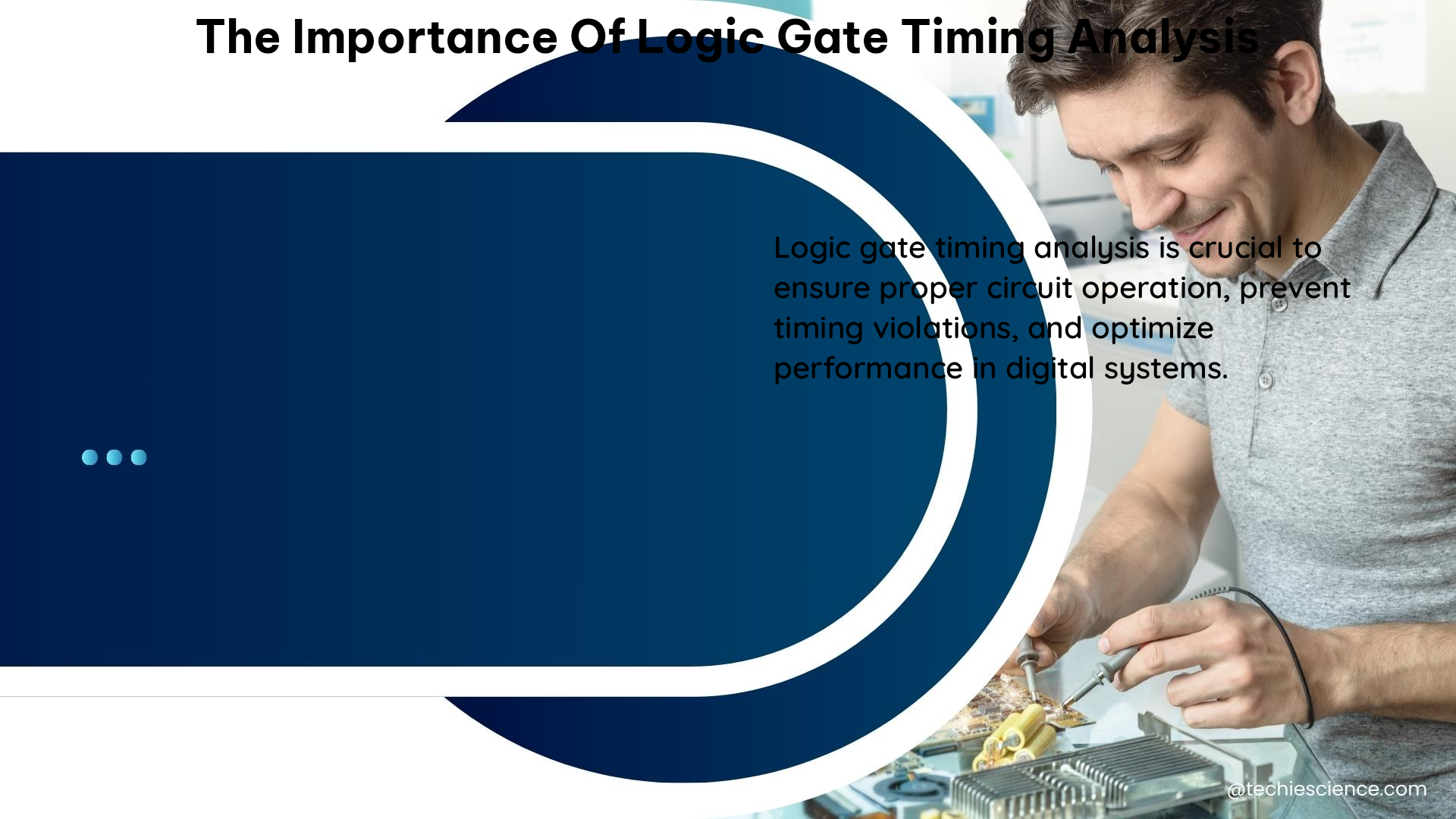Logic gate timing analysis is a critical aspect of digital circuit design, providing quantifiable data on the timing behavior of digital circuits. This analysis ensures that logic gates function correctly and meet the required performance specifications, making it an essential tool for electronics engineers and researchers.
Understanding the Fundamentals of Logic Gate Timing Analysis
In the context of CMOS logic gates, timing analysis involves performing post-layout simulations using extracted parameters from the cell layout. This process allows for the observation of the timing and DC characteristics of simple gates, as well as the determination of the critical path of combinational circuits.
The critical path is the longest path through a circuit, and its delay determines the maximum operating frequency of the circuit. By tracing the critical paths in a circuit schematic and confirming that they make sense intuitively, it is possible to ensure that the circuit will function correctly and meet the required performance specifications.
Measuring Timing Characteristics of Logic Gates

The timing characteristics of a logic gate are affected by parasitic capacitances, which can significantly impact the propagation delays and rise and fall times of the gate. For example, in the case of a CMOS inverter, the following timing characteristics are measured and recorded:
- Propagation Delays: The high-to-low and low-to-high propagation delays are measured and recorded.
- Rise and Fall Times: The rise and fall times of the gate output are measured and recorded.
- Gate Switching Threshold: The voltage level at which the gate switches from one state to the other is measured and recorded.
- Output High and Low Voltages: The voltage levels of the gate’s high and low output states are measured and recorded.
These measurements are crucial for ensuring that the gate functions correctly and meets the required performance specifications.
Analyzing the Impact of Parasitic Capacitances
Parasitic capacitances can have a significant impact on the timing characteristics of a logic gate. These capacitances can arise from various sources, such as the gate-source and gate-drain capacitances of the transistors, as well as the interconnect capacitances between the gate and other circuit elements.
To understand the impact of parasitic capacitances, consider the following example:
| Parasitic Capacitance | Typical Value |
|---|---|
| Gate-Source (Cgs) | 0.1 pF |
| Gate-Drain (Cgd) | 0.05 pF |
| Interconnect (Cint) | 0.2 pF |
In this example, the total parasitic capacitance seen by the gate is approximately 0.35 pF. This capacitance can significantly impact the propagation delays and rise and fall times of the gate, potentially causing the circuit to fail to meet its performance requirements.
Tracing Critical Paths in Combinational Circuits
In addition to measuring the timing characteristics of individual gates, it is also important to consider the timing implications of connecting multiple gates together. This is where the concept of the critical path comes into play.
The critical path is the longest path through a combinational circuit, and its delay determines the maximum operating frequency of the circuit. By tracing the critical paths in a circuit schematic and confirming that they make sense intuitively, it is possible to ensure that the circuit will function correctly and meet the required performance specifications.
For example, consider the following combinational circuit:
A
|
v
+---+---+
| |
| AND |
| |
+---+---+
|
v
B
In this circuit, the critical path is the path from input A to the output of the AND gate. By analyzing the timing characteristics of the AND gate and the interconnect delays, it is possible to determine the maximum operating frequency of the circuit and ensure that it meets the required performance specifications.
Applications of Logic Gate Timing Analysis
The importance of logic gate timing analysis can be seen in various applications, including the design of temporal logic gates for engineered bacteria.
Temporal Logic Gates in Engineered Bacteria
Temporal logic gates are used to sense and record the order of chemical inputs, as well as the timing between inputs and the duration of input pulses. By using unidirectional DNA recombination mediated by bacteriophage integrases, it is possible to detect and encode sequences of input events.
However, stochastic noise can create heterogeneous single-cell responses, which translate into analog population responses. By aggregating single-cell genetic states into population-level distributions, it is possible to deduce the order, timing, and duration of transient chemical events.
In this application, logic gate timing analysis is crucial for ensuring that the temporal logic gates function correctly and meet the required performance specifications, such as the ability to accurately detect and record the order, timing, and duration of chemical inputs.
Conclusion
Logic gate timing analysis is a crucial aspect of digital circuit design, providing measurable and quantifiable data on the timing behavior of gates and circuits. By performing post-layout simulations, measuring timing characteristics, and tracing critical paths, it is possible to ensure that gates and circuits function correctly and meet the required performance specifications.
Whether in the design of digital circuits or the development of temporal logic gates for engineered bacteria, the importance of logic gate timing analysis cannot be overstated. This analysis is a fundamental tool for electronics engineers and researchers, enabling the creation of reliable and high-performing digital systems.
References
- Post-Layout Timing Analysis
- Timing Analysis in Computer Science
- Temporal Logic Gates in Engineered Bacteria

The lambdageeks.com Core SME Team is a group of experienced subject matter experts from diverse scientific and technical fields including Physics, Chemistry, Technology,Electronics & Electrical Engineering, Automotive, Mechanical Engineering. Our team collaborates to create high-quality, well-researched articles on a wide range of science and technology topics for the lambdageeks.com website.
All Our Senior SME are having more than 7 Years of experience in the respective fields . They are either Working Industry Professionals or assocaited With different Universities. Refer Our Authors Page to get to know About our Core SMEs.